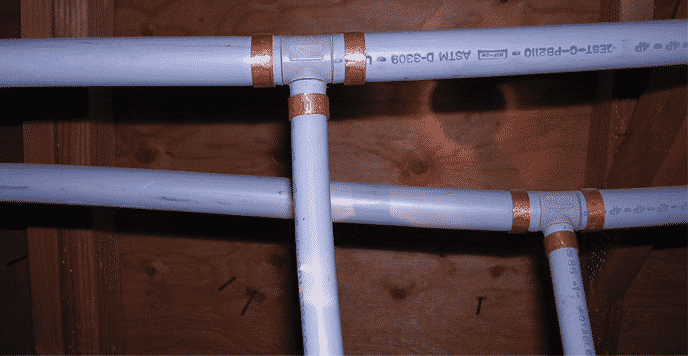Alright folks, let's dive into something that might not be the most glamorous topic, but is definitely something every homeowner in our beautiful corner of Victoria should be aware of: Poly B plumbing. Yes, we're talking about those grey plastic pipes that might be lurking behind your walls, and while they had their moment in the sun, they've also caused a fair bit of, shall we say, drama.

A BLAST FROM THE PAST (AND MAYBE NOT THE BEST ONE)
Back in the day, between the late 1970s and the mid-1990s, Polybutylene (Poly B) pipes were all the rage in residential construction across North America, and Victoria was no exception. They were seen as a cost-effective and flexible alternative to copper pipes. Plumbers loved them for their ease of installation, and builders appreciated the savings. It seemed like a win-win!
THE PLOT TWIST: TROUBLE BREWING
However, the honeymoon didn't last. Over time, homeowners started experiencing issues with their Poly B plumbing. The main culprit? Oxidation. It turns out that chlorine and other disinfectants commonly found in our municipal water supplies can react with the Poly B material, causing it to become brittle and develop micro-fractures.
And what happens when pipes become brittle and develop fractures? You guessed it: leaks. Not just little drips, mind you, but sometimes significant bursts that can lead to water damage, mold growth, and a whole lot of headaches (and hefty repair bills).
WHY INSURERS GET THE JITTERS
Now, you might be wondering why your insurance company raises an eyebrow (or maybe even two) when they hear the words "Poly B." Well, the history of leaks and the potential for future problems make Poly B a higher risk for water damage claims.
As a result, many insurance providers in Victoria and across BC have become increasingly cautious about insuring homes with Poly B plumbing. Some may refuse coverage altogether until the pipes are replaced, while others might impose higher deductibles or exclude water damage related to Poly B failure. It's always a good idea to check with your insurance provider to understand their stance on Poly B.
WHAT'S A HOMEOWNER TO DO?
If you own a home built during the Poly B era, it's crucial to know if you have these pipes. Here are a few telltale signs:
Colour: Poly B pipes are typically grey, but can also be black or blue.
Markings: Look for markings on the pipes that say "Polybutylene" or "PB" along with a size designation. These markings are often visible in unfinished areas like basements or utility rooms.
Fittings: The fittings used with Poly B pipes were often made of acetal plastic (usually white or grey) or copper.

A BLAST FROM THE PAST (AND MAYBE NOT THE BEST ONE)
Back in the day, between the late 1970s and the mid-1990s, Polybutylene (Poly B) pipes were all the rage in residential construction across North America, and Victoria was no exception. They were seen as a cost-effective and flexible alternative to copper pipes. Plumbers loved them for their ease of installation, and builders appreciated the savings. It seemed like a win-win!
THE PLOT TWIST: TROUBLE BREWING
However, the honeymoon didn't last. Over time, homeowners started experiencing issues with their Poly B plumbing. The main culprit? Oxidation. It turns out that chlorine and other disinfectants commonly found in our municipal water supplies can react with the Poly B material, causing it to become brittle and develop micro-fractures.
And what happens when pipes become brittle and develop fractures? You guessed it: leaks. Not just little drips, mind you, but sometimes significant bursts that can lead to water damage, mold growth, and a whole lot of headaches (and hefty repair bills).
WHY INSURERS GET THE JITTERS
Now, you might be wondering why your insurance company raises an eyebrow (or maybe even two) when they hear the words "Poly B." Well, the history of leaks and the potential for future problems make Poly B a higher risk for water damage claims.
As a result, many insurance providers in Victoria and across BC have become increasingly cautious about insuring homes with Poly B plumbing. Some may refuse coverage altogether until the pipes are replaced, while others might impose higher deductibles or exclude water damage related to Poly B failure. It's always a good idea to check with your insurance provider to understand their stance on Poly B.
WHAT'S A HOMEOWNER TO DO?
If you own a home built during the Poly B era, it's crucial to know if you have these pipes. Here are a few telltale signs:
Colour: Poly B pipes are typically grey, but can also be black or blue.
Markings: Look for markings on the pipes that say "Polybutylene" or "PB" along with a size designation. These markings are often visible in unfinished areas like basements or utility rooms.
Fittings: The fittings used with Poly B pipes were often made of acetal plastic (usually white or grey) or copper.
THE MILLION-DOLLAR QUESTION: SHOULD YOU REPLACE IT?
For many homeowners, the presence of Poly B plumbing raises the question of replacement. While not all Poly B systems will fail, the risk of failure increases with age and exposure to chlorinated water.
Here's a breakdown of factors to consider:
Age of the Plumbing: If your Poly B system is nearing or over 20 years old, the risk of issues increases.
Leak History: Have you experienced any leaks with your Poly B pipes in the past? This could be a sign of further problems to come.
Insurance Requirements: As mentioned earlier, your insurance provider's policies might necessitate replacement.
Peace of Mind: For many homeowners, the worry of potential leaks and the impact on insurance coverage is enough to warrant replacement for peace of mind.
For many homeowners, the presence of Poly B plumbing raises the question of replacement. While not all Poly B systems will fail, the risk of failure increases with age and exposure to chlorinated water.
Here's a breakdown of factors to consider:
Age of the Plumbing: If your Poly B system is nearing or over 20 years old, the risk of issues increases.
Leak History: Have you experienced any leaks with your Poly B pipes in the past? This could be a sign of further problems to come.
Insurance Requirements: As mentioned earlier, your insurance provider's policies might necessitate replacement.
Peace of Mind: For many homeowners, the worry of potential leaks and the impact on insurance coverage is enough to warrant replacement for peace of mind.
THE REPLACEMENT PROCESS
Replacing Poly B plumbing typically involves a professional plumber removing the existing pipes and installing new ones, usually made of PEX (cross-linked polyethylene) or copper. This can be a significant undertaking, depending on the size and layout of your home, but it's an investment that can protect your property and potentially improve your insurance options.
THE VIBE COLLECTIVE'S TAKEAWAY
At the Vibe Collective, we believe in empowering our clients with knowledge. Understanding the history and potential risks associated with Poly B plumbing is an important part of being a well-informed homeowner in Victoria. While those grey pipes might have seemed like a good idea at the time, the reality is they can lead to some serious headaches down the road.
If you're unsure about the type of plumbing in your home or have concerns about Poly B, don't hesitate to reach out to a qualified plumbing professional for an inspection. It's always better to be proactive and address potential issues before they turn into costly and stressful situations. After all, we want your Victoria home to be a haven, not a source of plumbing pandemonium!
Replacing Poly B plumbing typically involves a professional plumber removing the existing pipes and installing new ones, usually made of PEX (cross-linked polyethylene) or copper. This can be a significant undertaking, depending on the size and layout of your home, but it's an investment that can protect your property and potentially improve your insurance options.
THE VIBE COLLECTIVE'S TAKEAWAY
At the Vibe Collective, we believe in empowering our clients with knowledge. Understanding the history and potential risks associated with Poly B plumbing is an important part of being a well-informed homeowner in Victoria. While those grey pipes might have seemed like a good idea at the time, the reality is they can lead to some serious headaches down the road.
If you're unsure about the type of plumbing in your home or have concerns about Poly B, don't hesitate to reach out to a qualified plumbing professional for an inspection. It's always better to be proactive and address potential issues before they turn into costly and stressful situations. After all, we want your Victoria home to be a haven, not a source of plumbing pandemonium!

